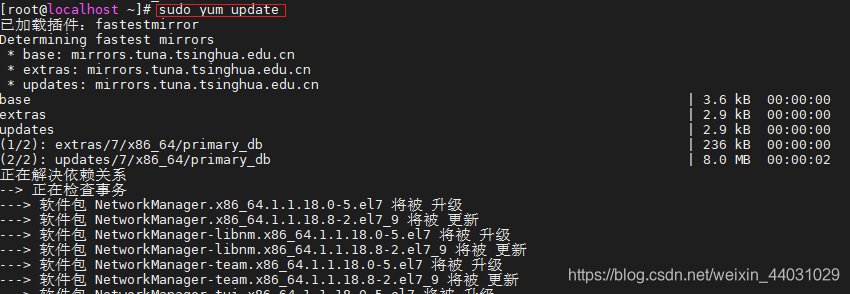Linux下CentOS7系统安装Docker(安装和卸载)
本文共 712 字,大约阅读时间需要 2 分钟。
安装步骤:
-
依据Docker安装规则CentOS系统的内核版本不低于3.10.0使用
uname -r命令查看自己的当前内核版本是否支持安装Docker.
-
更新下自己的yum包:
sudo yum update 按y继续下载
按y继续下载  更新完毕!
更新完毕! 
-
安装需要的软件包:
sudo yum install -y yum-utils device-mapper-persistent-data lvm2
-
设置yum源:
sudo yum-config-manager --add-repo https://download.docker.com/linux/centos/docker-ce.repo

- 查看仓库中docker版本,并选择特定版本进行安装:
yum list docker-ce --showduplicates | sort -r

-
安装docker:
sudo yum install docker-ce-17.12.0.ce

-
启动并设置开启开机启动
sudo systemctl start dockersudo systemctl enable docker
-
验证Docker是否安装成功(有client和service两部分表示docker安装启动都成功了):
docker version
-
查看Docker启动状态:
systemctl status docker
卸载步骤:
-
首先查看docker安装过的包:
yum list installed | grep docker
-
删除安装包:
yum remove docker-ce.x86_64

- 删除镜像,容器,配置文件等:
rm -rf /var/lib/docker
转载地址:http://pehmz.baihongyu.com/
你可能感兴趣的文章
Netty基础—2.网络编程基础四
查看>>
Netty基础—3.基础网络协议二
查看>>
Netty基础—7.Netty实现消息推送服务一
查看>>
Netty基础—7.Netty实现消息推送服务二
查看>>
Netty基础—8.Netty实现私有协议栈二
查看>>
Netty多线程 和 Redis6 多线程对比
查看>>
Netty学习总结(2)——Netty的高性能架构之道
查看>>
Netty学习总结(3)——Netty百万级推送服务
查看>>
Netty学习总结(5)——Netty之TCP粘包/拆包问题的解决之道
查看>>
Netty学习总结(6)——Netty使用注意事项
查看>>
Netty实现Http服务器
查看>>
Netty客户端断线重连实现及问题思考
查看>>
Netty工作笔记0001---Netty介绍
查看>>
Netty工作笔记0003---IO模型-BIO-Java原生IO
查看>>
Netty工作笔记0006---NIO的Buffer说明
查看>>
Netty工作笔记0007---NIO的三大核心组件关系
查看>>
Netty工作笔记0008---NIO的Buffer的机制及子类
查看>>
Netty工作笔记0009---Channel基本介绍
查看>>
Netty工作笔记0011---Channel应用案例2
查看>>
Netty工作笔记0012---Channel应用案例3
查看>>